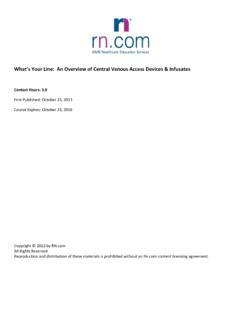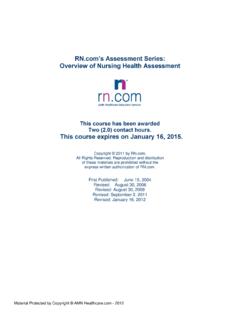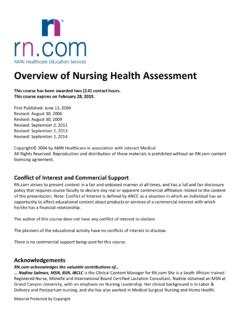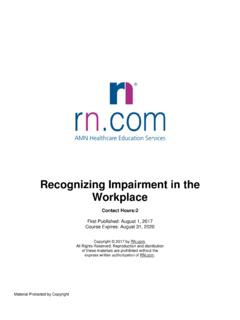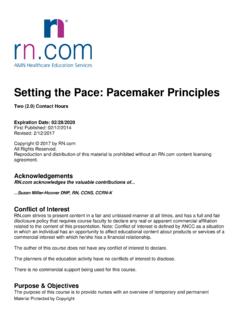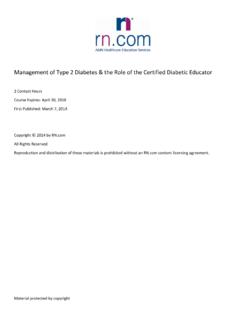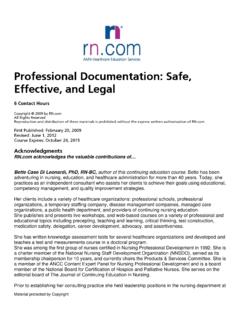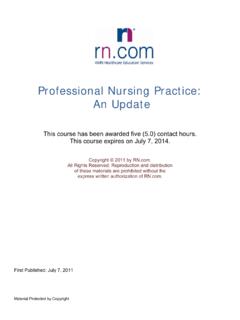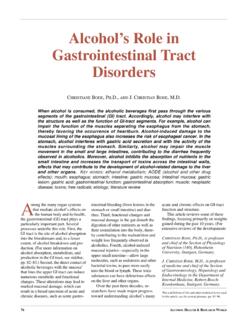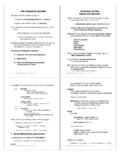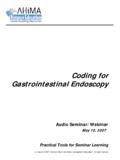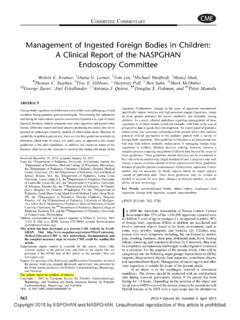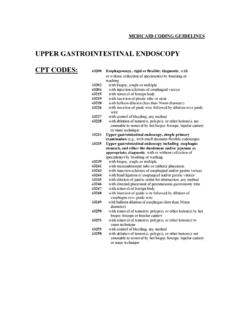Transcription of Gastrointestinal Anatomy and Physiology
1 Gastrointestinal Anatomy and Physiology This course has been awarded one ( ) contact hour Copyright 2004 by AMN Healthcare in association with Interact Medical. All Rights Reserved. Reproduction and distribution of these materials are prohibited without the express written authorization of AMN Healthcare. Course Expires: June 30, 2019 First Published: July 20, 2004 Revised: September 20, 2006 Revised: September 20, 2011 Revised: September 13, 2014 Disclaimer strives to keep its content fair and unbiased. The author(s), planning committee, and reviewers have no conflicts of interest in relation to this course. Conflict of Interest is defined as circumstances a conflict of interest that an individual may have, which could possibly affect Education content about products or services of a commercial interest with which he/she has a financial relationship.
2 There is no commercial support being used for this course. Participants are advised that the accredited status of does not imply endorsement by the provider or ANCC of any commercial products mentioned in this course. There is no "off label" usage of drugs or products discussed in this course. You may find that both generic and trade names are used in courses produced by The use of trade names does not indicate any preference of one trade named agent or company over another. Trade names are provided to enhance recognition of agents described in the course. Note: All dosages given are for adults unless otherwise stated. The information on medications contained in this course is not meant to be prescriptive or all encompassing. You are encouraged to consult with physicians and pharmacists about all medication issues for your patients.
3 Acknowledgements acknowledges the valuable contributions ..Kim Maryniak, RNC NIC, MSN, PhDc. Kim has over 25 years nursing experience with medical/surgical, psychiatry, pediatrics, and neonatal intensive care. She has been a staff nurse, charge nurse, educator, instructor, manager, and nursing director. Her instructor experience includes med/surg nursing, mental health, and physical assessment. Kim graduated with a nursing diploma from Foothills Hospital School of Nursing in Calgary, Alberta in 1989. She achieved her Bachelor in Nursing through Athabasca University, Alberta in 2000, and her Master of Science in Nursing through University of Phoenix in 2005. Kim is certified in Neonatal Intensive Care Nursing and is currently pursuing her PhD in Nursing. She is active in the National Association of Neonatal Nurses and American Nurses Association.
4 Kim s current and previous roles include research utilization, nursing peer review and advancement, education, use of simulation, quality, process improvement, leadership development, infection control, patient throughput, nursing operations, and professional development..Nadine Salmon, RN, BSN, IBCLC. Nadine is the Education Support Specialist for Nadine earned her BSN from the University of the Witwatersrand, Johannesburg, South Africa. She worked as a midwife in Labor and Delivery, an RN in Postpartum units and Antenatal units and then moved to the United Kingdom, where she worked as a medical surgical nurse. After coming to the US in 1997, Nadine worked in obstetrics and became a Board Certified Lactation Consultant.. Lori Constantine MSN, RN, C FNP, original course author. Purpose & Objectives The focus of this Gastrointestinal Anatomy and Physiology course is to teach you about the structures and functions of the Gastrointestinal system and its accessory organs.
5 The anatomical structures of the Gastrointestinal system work together to achieve three major goals. These goals are to digest, transport, and absorb nutrients. Understanding the fundamental structures and functions of the Gastrointestinal system and its accessory organs will allow you to provide care for all patients and intervene effectively for those with alterations in Gastrointestinal status. After successful completion of this course, you will be able to: Identify the functions of various anatomical structures within the Gastrointestinal system. Discuss the process of digestion, transport, and absorption within the Gastrointestinal system. Identify the functions of the accessory organs of the Gastrointestinal system; the liver, gallbladder, and the exocrine pancreas. Introduction The functions of the Gastrointestinal tract and its accessory organs are essential for life.
6 The process of digestion supplies nutrients to each and every cell in our body. If there is a disruption in any of these mechanisms, the whole body suffers. This course will provide healthcare professionals with information about the Anatomy and Physiology of the Gastrointestinal system. Glossary Bile: A greenish brown alkaline fluid secreted by the liver and concentrated in the gallbladder, which aids digestion. Bilirubin: Orange yellow pigment in the bile formed as a breakdown product of hemoglobin in the red blood cells. Caudate lobe: A small, well defined segment of an organ. Chyme: The thick, semifluid contents of the stomach. Clotting factors: Chemical and cellular constituents of the blood responsible for the conversion of fibrinogen into a mesh of insoluble fibrin causing the blood to coagulate or clot.
7 Conjugated bilirubin: (Also known as direct bilirubin.) Bilirubin that has been taken up by the liver cells and conjugated to form the water soluble bilirubin diglucuronide. Endocrine gland: A gland that secretes substances directly into the circulatory system; and include the pituitary, thyroid, parathyroid, and adrenal glands, the pineal body, and the gonads. Exocrine gland: A gland that secretes substances through a duct opening on an internal or external surface of the body. Hemolysis: Breakdown of red blood cells. Kupffer cells: Specialized cells in the liver that destroy bacteria, foreign proteins, and worn out blood cells. Lumen: Hollow part of the Gastrointestinal tract . Macrophages: White blood cells that destroy invading microorganisms. Partial Parental Nutrition (PPN): A solution, containing essential nutrients, which is injected into a vein to supplement other means of nutrition, usually a partially normal diet of food.
8 Thrombocytopenia: An abnormal drop in the number of platelets in the body. Platelets are blood cells involved in forming blood clots. Total Parental Nutrition (TPN): A solution containing all the required nutrients that is injected over several hours, into a vein. TPN provides a complete and balanced source of nutrients for patients who cannot consume a normal diet. All TPN consists of dextrose and amino acids, and may also consist of lipids. Unconjugated bilirubin: (Also known as indirect bilirubin). Bilirubin that is in a lipid soluble form, and circulates in loose association with the plasma proteins. Viscera: Soft, internal organs of the body. Structure and Functions of the Gastrointestinal tract Understanding the Anatomy and Physiology of the Gastrointestinal system is important in accurately assessing patients with Gastrointestinal disorders.
9 The Gastrointestinal tract is essentially a tube that extends from the mouth to the anus. It has generally the same structure throughout. There is a hollow portion of the tube known as the lumen, a muscular layer in the middle, and a layer of epithelial cells. These layers are responsible for maintaining the mucosal integrity of the tract . There are three main functions of the Gastrointestinal tract : Transportation Digestion Absorption of food The mucosal integrity of the Gastrointestinal tract and the functioning of its accessory organs are vital in maintaining the health of your patient. The Gastrointestinal tract s accessory organs include the liver, pancreas, and gallbladder (Scanlon, 2011). Organ Location The location of the organs can be divided into four quadrants: the right upper quadrant, the left upper quadrant, the left lower quadrant, and the right lower quadrant.
10 Right Upper Quadrant The right upper quadrant contains: Liver and gallbladder Duodenum The head of the pancreas The right adrenal gland A portion of the right kidney The hepatic flexure of the colon Portions of the ascending and transverse colon (Jarvis, 2011). Left Upper Quadrant The left upper quadrant contains: Left lobe of the liver Spleen Somach Body of the pancreas Left adrenal gland, a portion of the left kidney Splenic flexure of the colon Portions of the transverse and descending colon (Jarvis, 2011). Left Lower Quadrant The left lower quadrant contains: Lower pole of the left kidney Sigmoid colon A portion of the descending colon Left ureter Left ovary and fallopian tube or left spermatic cord (Jarvis, 2011). Right Lower Quadrant The right lower quadrant contains: Lower pole of the right kidney Cecum and appendix A portion of the ascending colon Right ureter Right ovary and fallopian tube, or right spermatic cord (Jarvis, 2011).
